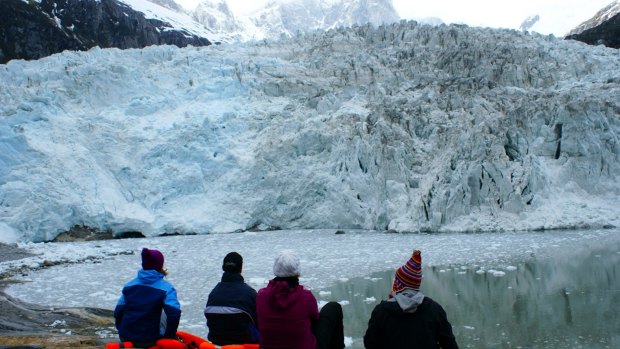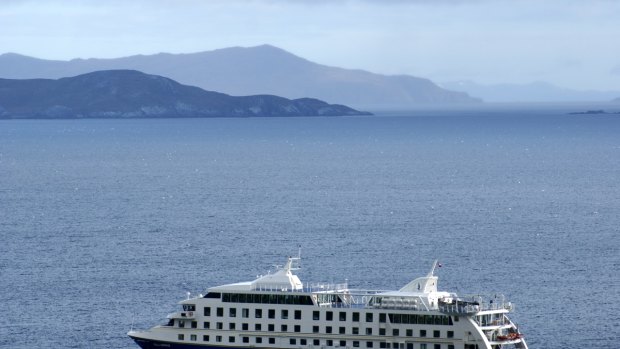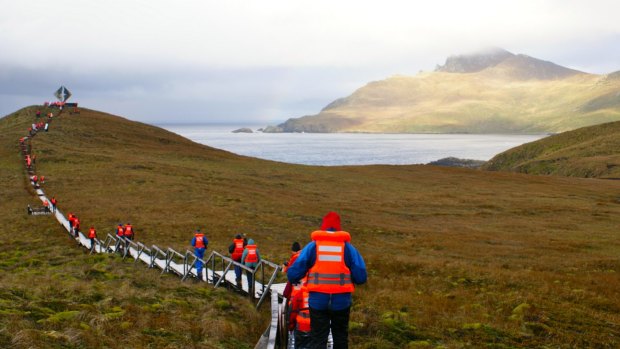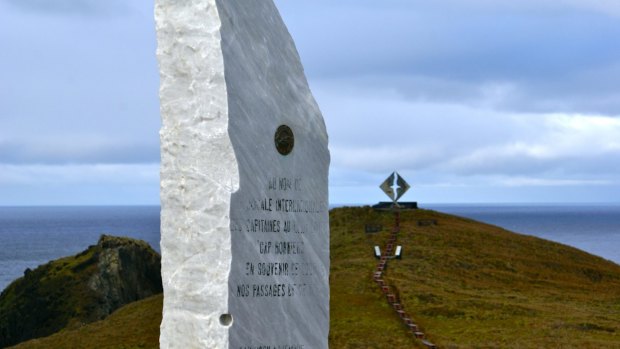This was published 9 years ago
Cruising: Rounding the Horn
Cruise: Rounding Cape Horn
By Louise Goldsbury

A front row seat to admire the massive Pia Glacier.Credit: Louise Goldsbury
Sailing around Cape Horn is the yachtie's equivalent of climbing Mount Everest – a glory-soaked survival of ferocious waves and the funnelling winds of the Southern Ocean, where latitudes are nicknamed the Roaring Forties, Furious Fifties and Screaming Sixties. Like an insatiable sea monster, its waters have swallowed 800 ships and 10,000 men.
Known as the sailors' graveyard, Cape Horn was not only the endpoint of life for so many, for centuries, it was also believed to be the end of the world. As the southernmost point of South America, the land forms the northern boundary of the Drake Passage, and is regarded as the spot where the Atlantic and Pacific oceans meet – not always cordially.
Rounding the Horn remains an iconic achievement, but for travellers there's an easier way to do it – a short cruise from Chile to Argentina. One of the smallest ships undertaking the expedition is the modern, 210-passenger MV Stella Australis, which makes the journey almost too safe and comfortable.

The Stella Australis at Hoorn Island.Credit: Louise Goldsbury
When we board at Punta Arenas, on a typically cold and windy afternoon, the swell is choppy enough to suggest adventure lies ahead. But first comes the astonishing beauty of Southern Patagonia and the Tierra del Fuego archipelago.
As the vessel navigates through the Strait of Magellan, passengers settle in the lounge to view chocolate-brown mountains sprinkled with snow. Then suddenly, the water below is carved up by a pod of dolphins. And that was just the first five minutes onboard.
In the morning, we arrive at Ainsworth Bay to see the Marinelli Glacier, with Cordillera Darwin reflected in the water. This mountain range, part of the Andes, is named after naturalist Charles Darwin, who explored the area in the 1830s aboard the HMS Beagle.

At Hoorn Island, passengers walk the hill toward the albatross memorial in honour of the 10,000 sailors who have died rounding Cape Horn. Credit: Louise Goldsbury
The native Yamana (also called Yaghan) people used to live naked and barefoot in this sub-polar forest, even throughout winter. Only one full-blooded Yamana person remains alive today, a woman named Cristina Calderón, born in 1928. Her son Luis is a chef on the Stella Australis.
According to our guide, there is an Australian connection with these South American nomads. Some anthropologists suggest our Aborigines were the first inhabitants of the area, arriving after an epic journey via Antarctica. In more recent times, Cape Horn was regarded as the halfway point for clipper ships carrying wool, grain, and gold from Australia to Europe from the 1700s to early 1900s.
In the afternoon, the Stella Australis moves to Tuckers Islet to visit a colony of Magellan penguins. As we transfer into smaller inflatable Zodiacs, sideways rain attacks, making photos near impossible. Fortunately, the weather improves for a hike to Pia Glacier and some scenic cruising through Glacier Alley in the Beagle Channel.

The Cape Horn Memorial at Hoorn Island. Credit: Louise Goldsbury
The next day is the attempted landing at Hoorn Island, about as close as the ship can get to Cape Horn, weather permitting. When we wake to smooth sea and blue sky, I'm disappointed by the pleasant climate and lush landscape of this supposedly ominous site.
But everything turns suitably sombre as black clouds roll in at tremendous speed. Adding to the adventurous spirit, crew in wetsuits have to stand in the freezing water to help passengers step from the Zodiacs to the island.
Dressed in matching red wet-weather gear (provided by the cruise company), we trudge uphill with heads bowed to avoid exposing our only bare skin to the icy wind. Our long line of 100 people forms a brightly coloured pilgrimage to the summit.
On top of the cliff is an albatross-shaped sculpture, erected in honour of the sailors who died in these treacherous waters. One by one, we wait our turn to pose in front and take selfies. It seems wrong to smile, but we're so happy to make it, as there is no guarantee of a landing if the water conditions are dangerous.
A further walk across the grass-covered terrain is a Chilean Navy station and lighthouse, a chapel and a house, where the naval officer lives with his family. He comes out for a chat and we ask if they get lonely without any neighbours. "No, your ship visits every week," he smiles.
To complete the expedition's goal, the Stella Australis must travel fully around the craggy coast, so we get back onboard for the official rounding of the Horn. Retreating inside to the lounge, everyone happily sips on plastic cups of hot grog (the traditional mariners' drink of sweetened warm rum), and we raise a toast to all those sailors who didn't make it.
Five other challenging cruise routes
Drake Passage
Crossing to Antarctica from Ushuaia (Argentina) takes two and a half days, often in very rough seas.
Gulf of Alaska
Emerging from the tranquil Inside Passage, conditions worsen on the way to Seward, Whittier or Anchorage.
Caribbean
Many ships are forced to divert to avoid tropical storms during hurricane season (June 1 - November 30).
Transatlantic
With little land to provide protection between Europe and the US east coast, repositioning cruises can get bumpy.
Bass Strait & Tasman Sea
Locally, the worst patches are between the Australian mainland and Tasmania and between Australia and New Zealand.
TRIP NOTES
MORE INFORMATION
GETTING THERE
LAN operates flights from Sydney to Ushuaia and Punta Arenas via Santiago. See lan.com.
CRUISING THERE
Cruceros Australis' Stella Australis sails from Punta Arenas, Chile, to Ushuaia, Argentina (and reverse) between September and April. Fares for a three-night voyage start at $1525 per person twin-share and include all meals, drinks (wine, beer, spirits, cocktails, tea, coffee and soft drinks), Zodiac rides and guided shore excursions.
The writer was a guest of Cruceros Australis and LAN.
Sign up for the Traveller Deals newsletter
Get exclusive travel deals delivered straight to your inbox. Sign up now.